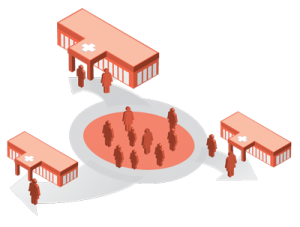As our clients know, Avantas is blessed to have engaged, smart, and energetic team members who are as committed to learning as they are to providing excellent service. One team member who is always building her knowledge and gaining expertise is Jenny Korth. Jenny is a senior consultant and one of our experts driving the tailoring of our enterprise strategies to benefit medical groups. Following is a piece Jenny contributed on that very topic.
Enjoy, and please feel free to reach out to me at jackie.larson@avantas.com to learn more about the work we are doing within medical groups and outpatient networks.
Medical practices today are dealing with a myriad of challenges, namely rising operational costs and the effort associated with assessing current operations to identify opportunities for improvement, according to a recent survey conducted by MGMA. The range of factors to consider when dealing with these challenges is vast and cover almost every facet of the practice. With this breadth of potential areas of focus it is hard for practice executives to know where to start. As labor is one of the largest expenditures, it stands to reason that this would be it. Having a comprehensive view of your current state, both your current workforce and the operations of the practice, is key to know what improvements and next steps are needed.
Analyzing Your Workforce
 When analyzing your workforce, the place to start is with a review your workload targets and the staff needed to support these targets. Next, identify the trends and reasons why your staff are taken away from the core business operations. These commonly include such things as attending training or meetings, taking vacations, or calling in sick. This is key to establishing a layer of contingency staff to call on when additional needs arise through an increase in volumes or when core staff are unavailable.
When analyzing your workforce, the place to start is with a review your workload targets and the staff needed to support these targets. Next, identify the trends and reasons why your staff are taken away from the core business operations. These commonly include such things as attending training or meetings, taking vacations, or calling in sick. This is key to establishing a layer of contingency staff to call on when additional needs arise through an increase in volumes or when core staff are unavailable.
We often see that having clear workload targets that vary with the fluctuation of patients is a gap most practices have. If you staff at the same level for 20 patients as you would for 40 and/or if your Monday day staffing is the same as your Wednesday afternoon staffing, then this is your first opportunity.
Operational Analysis
Organizations need clear guidelines that help staff know the expectations for their position and expected workflow within the practice. Examples would cover who rooms a patient upon arrival or the procedures to follow when schedule changes need to be made for staff absences or requesting vacation time. When deviations from the established process occur it creates confusion and possibly frustration among staff and physicians and results in decreased efficiency. Identifying the differences between policies and actual practices will provide opportunity to standardize and improve.
Another area of focus includes scheduling policies for staff and physicians. This is especially important since staffing needs will be impacted by a physician’s schedule. Policies that define when a physician’s schedule should be finalized (including their time off, time committed to academic organizations for lecturing, etc.) must be documented and uniform across the medical group. Similar requirements for when staff and physicians need to call-in ill should also be in place. Among other things, this policy should define the number of occurrences that would necessitate disciplinary action (and what that action should be) as well as clarity on what constitutes a “late” call-in.
Additionally, an operational analysis should look for the “workarounds” that are widely adopted and therefore do not necessarily register as a variance. Questioning why things are done a certain way and getting, “because we’ve always done it this way,” is a clear indication that a certain practice has not evolved since its inception and should be reevaluated.
When analyzing your processes and policies keep in mind how much healthcare has changed since they were written or first implemented. We have all come to the realization that we cannot continue business as usual if we are to remain viable in the face of historic change. Outdated or redundant processes, as well as those that could be automated, must be revised.
Implementing Change
Change is difficult, and this type of change is heavy lifting. It affects not only your processes but your culture. It is essential that proper attention is paid to change management best practices if this transformation is going to be successful and enduring.
Having a clear understanding of where you are today will be the foundation for moving forward. As you define the vision of what your future state can and should be you’ll have the necessary chart to map the changes needed to get you there.


